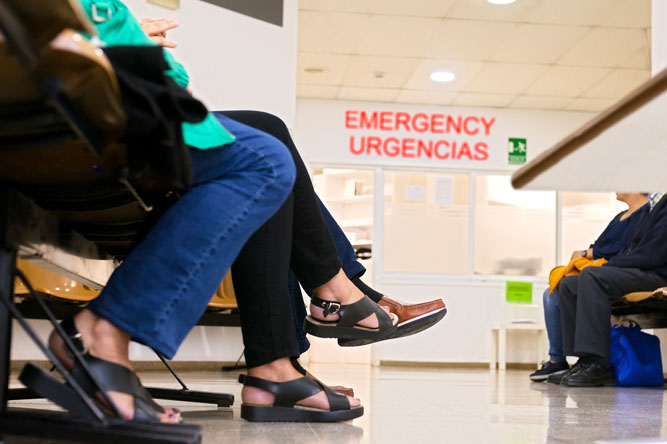
Current Hospital Discharge Conflicts Due to SNF Staff Shortages
Many hospital systems continue to report operating losses, largely attributable to high operating costs. The high operating costs are reflective of the wage and benefit increases that hospitals provided to staff in response to staffing shortages during the pandemic and thereafter as a more desirable alternative than using agency staff.
Nursing homes have the same problem, and despite the attractive compensation packages, they still suffer from labor shortages. The American Health Care Association (AHCA) and National Center for Assisted Living (NCAL), using data compiled by the Bureau of Labor Statistics (BLS), discovered the loss of approximately 210,000 nursing home workers since 2020.[1] AHCA/NCAL’s same breakdown of data suggests it may take until 2027 for nursing homes to employ the same number of workers as they had before the pandemic.
The SNFs’ staffing struggles have resulted in a health care crisis in which the facilities often do not have adequate staff to care for discharges referred by hospitals, and the discharges are mounting. A recent study, from data collected between April 1 and June 30 of 2022, released by the Hospital Association of New York State, found that among the 1,115 patients studied among 52 participating hospitals that there were 60,000 delayed days of discharge at a cost of approximately $169 million.[2]
The inability to discharge patients to a post-acute setting results in excess variable costs as well as opportunity costs from a decline in admissions. This is a microcosm of a greater problem that hospitals continue to experience nationwide with the challenge of discharging patients.
Discover how HDG developed a partnership between a health system and a SNF allowing the system to free up scarce beds while simultaneously filling the SNF’s empty wing.
Programs Impacting Hospital Patient Discharge
Hospital-at-Home and Its Impact on Patient Discharge
According to the AARP bulletin dated September 2023, nearly 300 hospital-at-home programs are operating in the U.S., and by 2030, 17 percent of hospitals will offer these programs, according to Jonathan Kelly, MD, the medical director of NYU Langone Hospital Long Island Home Hospital Program.[3]
Hospital at Home programs are designed for patients who have moderate acuity. Patients can be admitted either from the emergency department or, in some cases, from inpatient units. Typically, patients with cellulitis, chronic obstructive pulmonary disease, pneumonia, urinary tract infections, or congestive heart failure usually qualify for hospital-at-home. Patients who need moderate acute care and are stable can be cared for at home, receiving support from caregivers who visit the home. They also receive support from internet-based remote patient monitoring. In regard to the senior population’s overall internet use, which, in turn, applies to internet-based remote monitoring, the Pew Data Research Center determined that in the year 2000, 14 percent of the 65-plus population used the internet compared to the 75 percent that uses it today.[4] So, older adults, most of whom are insured by traditional Medicare or a Medicare Advantage plan, are capable of and comfortable with using the internet, on which remote monitoring devices depend.
In 2016, Cochrane Reviews studied 16 randomized control trials and evaluated the effectiveness of hospital-at-home programs versus traditional hospitals. The review found no difference in six-month mortality and no difference in being transferred or readmitted to a hospital. It also found that hospital-at-home patients enjoyed higher satisfaction and lower costs than patients admitted to the hospital.[5]
The cost of a hospital-at-home admission is 42 percent less than an equivalent hospitalization, according to Presbyterian Healthcare Services.[6] It should be noted, however, that over 12 years, Presbyterian Healthcare Services admitted 1,400 patients to their hospital-at-home program, or 116 patients per year, a minute fraction of overall acute care patients. Although hospital-at-home programs may be safe and popular among some, they only represent a low number of acute care patients who would otherwise be in the hospital.
Medicare created a waiver for hospital-at-home patients during the pandemic, which will remain in place until the end of 2024. Most of the hospital-at-home patients are insured by Medicare. It’s unclear whether hospital-at-home will become a program that continues to be reimbursed by Medicare. Most commercial insurers do not cover hospital-at-home reimbursement.
Hospital-at-home programs can be challenging to implement. They require medical staff, particularly home care nurses, to visit hospital-at-home patients regularly. Hospitalists or ED physicians and, at times, the patient’s primary care physician must order or approve an admission to hospital-at-home. Ultimately, patients need to agree to be cared for as part of a hospital-at-home program and have a living situation that is conducive to a hospital-at-home admission.
Hospital-at-home may result in a slight reduction in inpatient days. However, due to the overall low numbers of patients admitted into these programs and the uncertainty of the Medicare waiver, it is unlikely to make a dramatic and meaningful impact on reducing overall excess patient days.
 Telehealth Also Impacting Patient Discharge
Telehealth Also Impacting Patient Discharge
Telehealth, which became popular during the pandemic, essentially allows patients, through the aid of technology, to receive medical consults using a computer or mobile device. Telehealth is essentially limited to non-acute care. Services such as mental health, skin conditions, care resulting from viruses and bacterial infections, as well as physical and occupational therapy, can be provided through telehealth.
Medicare patients can receive telehealth services in their home. Telehealth services can be provided by all eligible Medicare providers. It is unclear if the Department of Health and Human Services (HHS) will extend telehealth waivers beyond 2024 and make the program permanent. Since this service is mostly used for non-acute conditions, it is not a viable strategy to decrease patient length of stay.
A Better Solution to Impact Hospital Discharges
The most significant means by which hospital lengths of stay can be reduced is through patient discharge to post-acute settings, such as nursing homes or home health agencies. Home health agencies are typically not positioned to handle high acuity patients. Nursing homes, however, can service patients who need skilled nursing care. In fact, a recent study conducted by CMS and recently published in JAMDA, found that of nursing home residents who skilled in place for six conditions (urinary tract infections, COPD, skin infection, dehydration, pneumonia, and CHF), 13.6 percent were subsequently hospitalized and 7.8 percent died within 30 days, compared to 26.5 percent and 17.0 percent respectively among those treated in a hospital.[7] Nursing homes with adequate staffing and clinical expertise continue to demonstrate that they can successfully care for patients who require acute care.
Now, after significant upheaval in the industry, development of a high-performance nursing home network, leasing of nursing home beds, and clinical integration with nursing homes are just a few ways in which hospitals can decrease their excess patient days.
HDG Can Help
Health Dimensions Group (HDG) has experts who can help hospitals and health systems improve discharge to SNFs by developing a post-acute partnership. Our experienced consultants provide essential guidance for creating partnerships that result in improved strategic, operational, and financial outcomes, highlighting each partner’s unique value in the continuum. If you would like to learn more about how HDG can assist you, please contact us at 763.537.5700 or info@hdgi1.com.
[1] AHCA/NCAL [2] HANYS [3] AARP [4] Pew Research Center [5] Cochrane Reviews [6] The Value Initiative [7] JAMDA






